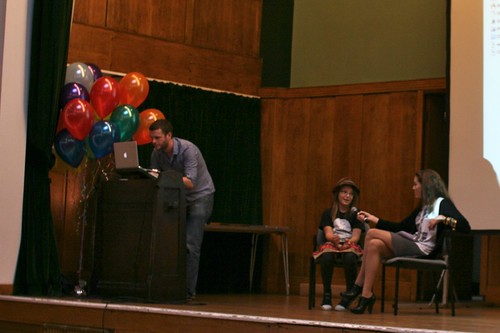 Gameification. Points. Badges. Gamepocalypse. External rewards. Every day the headlines about games remind us that there must be more to games than these keywords. The game industry has sometimes a bad navel gazing habit... which is why it's good to attend event such as the playful10 conference in London last Friday. The point of this conference is to "look at what PLAY means both creatively and culturally, and put speakers on the stage who offer different perspectives on where we are currently, where we’ve been, and where we’re going. We want people walking away talking about the nature of games… what they mean to different people inside, on the periphery, outside or miles away from the industry".
Gameification. Points. Badges. Gamepocalypse. External rewards. Every day the headlines about games remind us that there must be more to games than these keywords. The game industry has sometimes a bad navel gazing habit... which is why it's good to attend event such as the playful10 conference in London last Friday. The point of this conference is to "look at what PLAY means both creatively and culturally, and put speakers on the stage who offer different perspectives on where we are currently, where we’ve been, and where we’re going. We want people walking away talking about the nature of games… what they mean to different people inside, on the periphery, outside or miles away from the industry".

The playful10 conference was certainly as good as last year's: passionate speakers (ranging from comic book writers to hair dressers), intriguing topics (old jew jokes, item collections from badge to game controllers, Mad Men quotes, dead chicken, critics about gameification), good audience and cosy venue.
Some quick notes below about what inspired me:

In his introduction, Toby Barnes first claimed that "not all play is created equal" and that we need to go back again. To clarify this, he then pointed to H.G. Wells' classic victorian wargame books from 1913: "Little Wars" and "Floor games" with great quotes such as "the home that has no floor upon which games may be played falls so far short of happiness". or "How utterly we despise the silly little bricks of the toyshops! They are too small to make a decent home for even the poorest lead soldiers, even if there were hundreds of them, and there are never enough, never nearly enough; even if you take one at a time and lay it down and say, "This is a house," even then there are not enough". The importance of the floor (and other structures to play games) has also been re-asserted later on by another speaker who presented a project for racing games on sidewalks. Barnes' second point to start off the day was also that creating games is hard. Based on this tweet ("Deciding that games design is 20% fun, 80% frustration."), he showed that reversing the percentages is a matter of iterating (as suggested by Matt Locke), so "let's keep iterating".
Naomi Alderman discussed the problem of storytelling in video-games: "it's almost impossible to tell the player something about the character at the same moment you give him/her total freedom about what to do".
Paul Bennun, in his presentation about audio games, showed intriguing videos from loneconspirator. Based on this material, he described how audio games indeed make you look like a dork but the user is definitely "in flow". Audio games are just like any other games: some are good, some are bad. Eventually, when you get rid of the screen, you find yourself more free, have less constraints and it's because of how sounds work. As a matter of fact, the difficulty here is that sound can only be "in the moment" and this is why it's so immersive, especially for first person games.

Tom Muller unveiled inspiring examples of his work about graphic design and comic books. He basically showed the importance of typography in these fields and I quite enjoyed examples such as World's best robot, World war robot, Pop Bot and 24SEVEN, which seems to be tremendously interesting.
Development director at TT Games, Jonathan Smith worked for the production of LEGO Star Wars. In his talk, he claimed that game design revolved around a conflict finely described by Dr. Miller in the second episode of Mad Men (4th season):
"Faye Miller: Look, we're both in the same business. I'm not embarrassed to say. It's about helping people somehow to sort out their deepest conflict.
Don Draper: And what is that?
Faye Miller: In a nutshell, It all comes down to "what I want" versus "what's expected of me."
Freedom versus constraints. He showed that people who play video-games are not there to be indulged and that they want to be "directed by the system". They want to find the boundaries and the rules through communicated affordances. The game designer creates an awareness of the permitted possibilities... to create play.
Then Sebastian Deterding gave an insightful analysis of "gameification and its discontents". He started by asserting that there's a disease currently on the web: the "badge measle", i.e. the pervasive presence of rewards such as badges. These are being given for tons of reasons ranging from posting a blogpost to watching a TV channel. It is as if points and other rewards were given to achieve life goals. Deterding simply wondered about "what the hell is going here?". His critique focused on the idea that game mechanism are now perceived as a crunchy thing you can add to anything, a trend weirdly called "gameification" and propelled by game designers, "talking heads" and - worse - service vendors.
He followed on this by addressing what is wrong with gameification:
- Confusion 1: games are not fun because they are games, they are fun because they are well designed! Sturgeon's Law "Ninety percent of everything is crap"
- Confusion 2: rewards are not achievements, this is just bad psychology. Vendors who sell this have a Pavlovian model in mind. "it's so 1940" as Deterding said. He exemplified this by showing a game on which there's big button called "earn 1,000,000,000,000 $" on which you can click and win. Based on the reward model, this would be the best game. As described by Raph Koster, "fun in games arises from mastery".
- Confusion 3: competition is not for everyone!
The problem is also that gameification also has side-effects: it creates unintended behavior, people game the system and it messes with implicit social norms.
When people take gameification too directly, they generally miss that games are about: fictions, make believe, talk, and freedom to play ("whoever plays plays freely, whoever must play cannot play!"). Playing = "as if" and playing is fun because of the autonomy. As shown on Deterding's slide below, this is the difference between work (a spreadsheet) and play (Eve On-line):

After this, Bertrand Duplat from Editions Volumiques showed some of the awesome prototypes they recently produced. And then I had to catch my flight missing the last speakers.